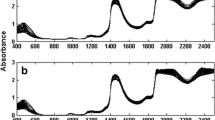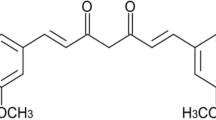Abstract
Powdered soft drinks (PSDs), fortified with antioxidants such as ascorbic acid (AA), are normally controlled by titration or chromatographic methods. This study evaluated the feasibility of using near-infrared spectroscopy (NIRS) and multivariate analysis to predict AA contents in PSDs as an alternative not-destructive method. The AA content of sixty-seven samples of commercial fortified grape and passion fruit PSDs was analyzed by the standard method (titration) and showed significant variance between flavors within the same brand. In addition, 75% of the samples required from 0.3 to 10.2 more cups of grape than passion fruit flavor to supply the AA Reference Nutrient Intake for children and adults. Spectral and reference data sets were split into calibration and validation sets. Partial least squares regression models were built and validated for the determination of AA in both PSDs. The model’s basic statistics for grape flavor PSDs (RMSEC = 0.49 mg g−1, R2cal = 0.84; RMSECV = 0.67 mg g−1, R2CV = 0.70; RMSEP = 0.50 mg g−1, R2pred = 0.84), and that for passion fruit flavor PSDs (RMSEC = 0.24 mg g−1, R2cal = 0.95; RMSECV = 0.56 mg g−1, R2CV = 0.76; RMSEP de 0.57 mg g−1, R2pred = 0.72) indicated that NIRS-PLS methodology produced reasonable results. The limits of detection and quantification obtained showed that the method is useful to detect and quantify AA in the studied samples. A new set of grape drinks was used for external prediction and the RMSEP was 0.62 mg g−1, R2pred was 0.72. Based on the results, NIRS–multivariate analysis proved to be useful for quality control of AA in commercialized grape and passion fruit in PSDs and a faster, objective and environmentally friendly method alternative to standard methods.



Similar content being viewed by others
References
ABIR (2015) Powdered soft drinks. Brazilian Association of soft drink and non-alcoholic beverages Industry. http://abir.org.br/o-setor/dados/refrescos-em-po/. Accessed 29 May 2016
Alamar PD, Caramês ETS, Poppi RJ, Pallone JAL (2016) Quality evaluation of frozen guava and yellow passion fruit pulps by NIR spectroscopy and chemometrics. Food Res Int 85:209–214. https://doi.org/10.1016/j.foodres.2016.04.027
Amodio ML, Ceglie F, Chaudhry MMA, Piazzolla F, Colelli G (2017) Potential of NIR spectroscopy for predicting internal quality and discriminating among strawberry fruits from different production systems. Postharvest Biol Technol 125:112–121. https://doi.org/10.1016/j.postharvbio.2016.11.013
AOAC (1984) Official Methods of Analysis, 14th edn. Association of Official Analytical Chemistry, Washington
Benassi MT, Antunes AJA (1988) Comparison of metaphosphoric and oxalic acids as extractants solutions for the determination of vitamin C in selected vegetables. Arquivos de Biologia e Tecnologia 31(4):507–513
Betemps DL, Fachinello JC, Galarça SP (2011) Visible spectroscopy and near infrared (VIS/NIR), in assessing the quality of mangoes Tommy Atkins. Revista Brasileira de Fruticultura 33:306–313. https://doi.org/10.1590/S0100-29452011000500038
Brazil (1978) Regulation n. 12 from July 24, 1978 (Regulação n.12, de 24 de julho de 1978). Diário Oficial da União, Brasília (DF): July 24, 1978. Section 1
Brazil (1998a) Ordinance n.544 from November 16, 1998 (Portaria n.544, de 16 de novembro de 1998). Ministry of Agriculture, Livestock, and Food SupplyDiário Oficial da União, Brasília (DF): November 17, 1998
Brazil (1998b) Ordinance n.31 from January 13, 1998 (Portaria n.31, de 13 de janeiro de 1998). Ministry of Health, National Health Surveillance Agency. Diário Oficial da União, Brasília (DF): March 30, 1998. Section I-E
Brazil (1998c) Ordinance n.27 from January 13, 1998 (Portaria n.27, de 13 de janeiro de 1998). Ministry of Health, National Health Surveillance Agency. Diário Oficial da União, Brasília (DF): July 17, 1998
Brazil (2009) Decree n. 6871, from July 4, 2009 (Decreto n. 6871, de 4 de Junho de 2009). Ministry of Agriculture, Livestock, and Food Supply. Diário Oficial da União, Brasília (DF): June 5, 2009. Section 1
Brazil (2013) Normative Instruction n.17 from June 19, 2013 (Instrução Normativa n.17, de 19 de Junho de 2013). Ministry of Agriculture, Livestock, and Food Supply. Diário Oficial da União, Brasília (DF): June 20, 2013 - Seção 1
Caleguer VF, Toffoli EC, Benassi MT (2006) Acceptance of commercial powdered orange flavored refreshment and their correlation to physicochemical parameters. Semina: Ciências Agrárias 27(4):587–598
Caramês ETS, Alamar PD, Poppi RJ, Pallone JAL (2017) Quality control of cashew apple and guava nectar by near infrared spectroscopy. J Food Compos Anal 56(Supplement C):41–46. https://doi.org/10.1016/j.jfca.2016.12.002
Cruz RAN, Lobato LP, Santos JS (2013) Ascorbic acid in powdered soft drinks in lemon and orange flavors (Ácido ascórbico em preparados sólidos para refresco sabores limão e laranja). Scientia Plena 9(11):5p
Ferreira MMC (2015) Chemometrics—concepts, methods and applications (Quimiometria—Conceitos, Métodos e Aplicações). Editora da Unicamp, Campinas
Flores DWM (2015) Non-invasive systems for oranges classification by means of physical and chemical parameters. Dissertation, Luiz de Queiroz College of Agriculture (ESALQ)
Granato D, Piekarski FVBW, Masson ML (2012) Assessing the ascorbic acid contents in beverages and powdered juices: comparison between the experimental data and the values displayed on the product label. Revista do Instituto Adolfo Lutz (Impresso) 71:331–336
Malegori C, Grassi S, Marques EJN, De Freitas ST, Casiraghi E (2016) Vitamin C distribution in acerola fruit by near infrared hyperspectral imaging. J Spectr Imaging 5(a6):1–4. https://doi.org/10.1255/jsi.2016.a6
Maniwara P, Nakano K, Boonyakiat D, Ohashi S, Hiroi M, Tohyama T (2014) The use of visible and near infrared spectroscopy for evaluating passion fruit postharvest quality. J Food Eng 143:33–43. https://doi.org/10.1016/j.jfoodeng.2014.06.028
Nicolaï BM, Beullens K, Bobelyn E, Peirs A, Saeys W, Theron KI, Lammertyn J (2007) Nondestructive measurement of fruit and vegetable quality by means of NIR spectroscopy: a review. Postharvest Biol Technol 46:99–118. https://doi.org/10.1016/j.postharvbio.2007.06.024
Rosa SES, Cosenza JP, Leão LTS (2006) Overview of the Brazilian beverage sector, vol 40. BNDES Setorial, Rio de Janeiro, pp 101–150
Santos DA (2015) Multiproduct multivariate calibration model development to quantify the acidity and vitamin C in industrialized fruit nectar and soy juices. Dissertation, Federal University of Technology - Paraná
Silva PT, Fialho E, Lopes MLM, Valente-Mesquita VL (2005) Industrialized orange juices and powdered soft drinks: chemical and physical-chemical stabilities (Sucos de laranja industrializados e preparados sólidos para refrescos: estabilidade química e físico-química). Ciênc Tecnol Aliment 25(3):597–602. https://doi.org/10.1590/S0101-20612005000300033
Sinelli N, Spinardi A, Egidio V, mIGnani I, Casiraghi E (2009) Evaluation of quality and nutraceutical content of blueberries (Vaccinium corymbosum L.) by near and mid-infrared spectroscopy. Postharvest Biol Technol 50(1):31–36. https://doi.org/10.1016/j.postharvbio.2008.03.013
Webb FS, Whitney EN (2003) Nutrition: concept and controversies, 9th edn. Wadsworth Thomson Learning, Australia, pp 211–237, 277–290
Souza AP (2007) Hygroscopic behavior and physical evaluation, physical-chemical and mineral of solid preparation to drink in flavors mango, orange, passion fruit and pineapple. Dissertation, Federal University of Ceará
Stuart BH (2004) Infrared spectroscopy: fundamentals and applications. Wiley, Chichester
Workman J, Weyer L (2012) Practical guide and spectral atlas for interpretive near-infrared spectroscopy, 2nd edn. Taylor & Francis Group, LLC, Florida
Funding
CAPES (Grant Number 001) and CNPq (Grant Number 132497/2017-4).
Author information
Authors and Affiliations
Corresponding author
Ethics declarations
Conflict of interest
The authors declare no conflict of interest.
Ethical approval
This article does not contain any studies with human participants performed by any of the authors.
Informed consent
Not applicable.
Additional information
Publisher's Note
Springer Nature remains neutral with regard to jurisdictional claims in published maps and institutional affiliations.
Rights and permissions
About this article
Cite this article
Santana, M.C., Ferreira, M.M.C. & Pallone, J.A.L. Control of ascorbic acid in fortified powdered soft drinks using near-infrared spectroscopy (NIRS) and multivariate analysis. J Food Sci Technol 57, 1233–1241 (2020). https://doi.org/10.1007/s13197-019-04154-1
Revised:
Accepted:
Published:
Issue Date:
DOI: https://doi.org/10.1007/s13197-019-04154-1




